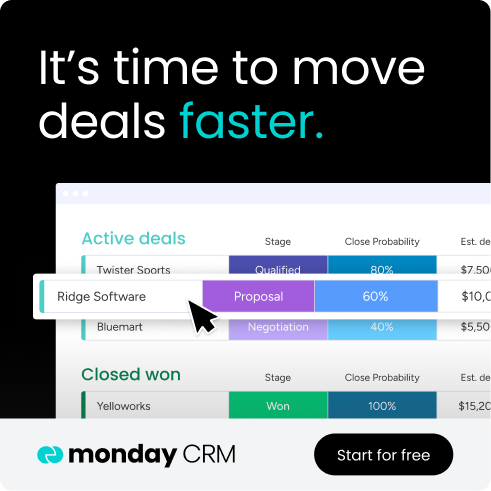Your sales team generates hundreds of leads monthly, but only a fraction convert into revenue. The challenge isn’t lead volume, it’s knowing which prospects deserve immediate attention and which ones can wait. Traditional lead scoring relies on manual rules and gut instinct, creating bottlenecks that let hot prospects slip through while reps chase dead ends.
AI lead scoring changes this equation entirely. Instead of static point systems, machine learning algorithms analyze hundreds of data points simultaneously to predict conversion probability in real time. The technology identifies patterns humans miss, like the correlation between mobile pricing page visits and deal velocity, then automatically prioritizes your pipeline based on genuine buying signals.
Let’s break down how AI lead scoring works, why it beats traditional methods, and how you can implement it without the headaches. We’ll cover the core technology, practical benefits, implementation steps, and best practices that help revenue teams focus their energy on prospects most likely to buy.
Key takeaways
- Catch hot prospects instantly: AI scores thousands of leads in seconds, ensuring sales never misses a buyer at their moment of highest interest, unlike slow manual systems.
- Focus on qualified leads: AI identifies which prospects match the behavior patterns and buying signals of your best customers, maximizing sales team productivity by eliminating time wasted on poor fits.
- Get predictable pipeline performance: data-driven insights from AI analysis lead to accurate forecasts and effective resource planning, giving sales leaders confidence in their projected numbers.
- Scale qualification effortlessly: AI automatically qualifies, scores, and routes prospects, enabling teams to handle a $mathbf{10 times}$ increase in lead volume without requiring additional staff.
- Autonomous lead engagement: the functionality offered by platforms like monday CRM exemplifies this evolution by proactively calling new leads within seconds, qualifying them through intelligent conversations, and booking meetings for sales representatives.
What is AI lead scoring?
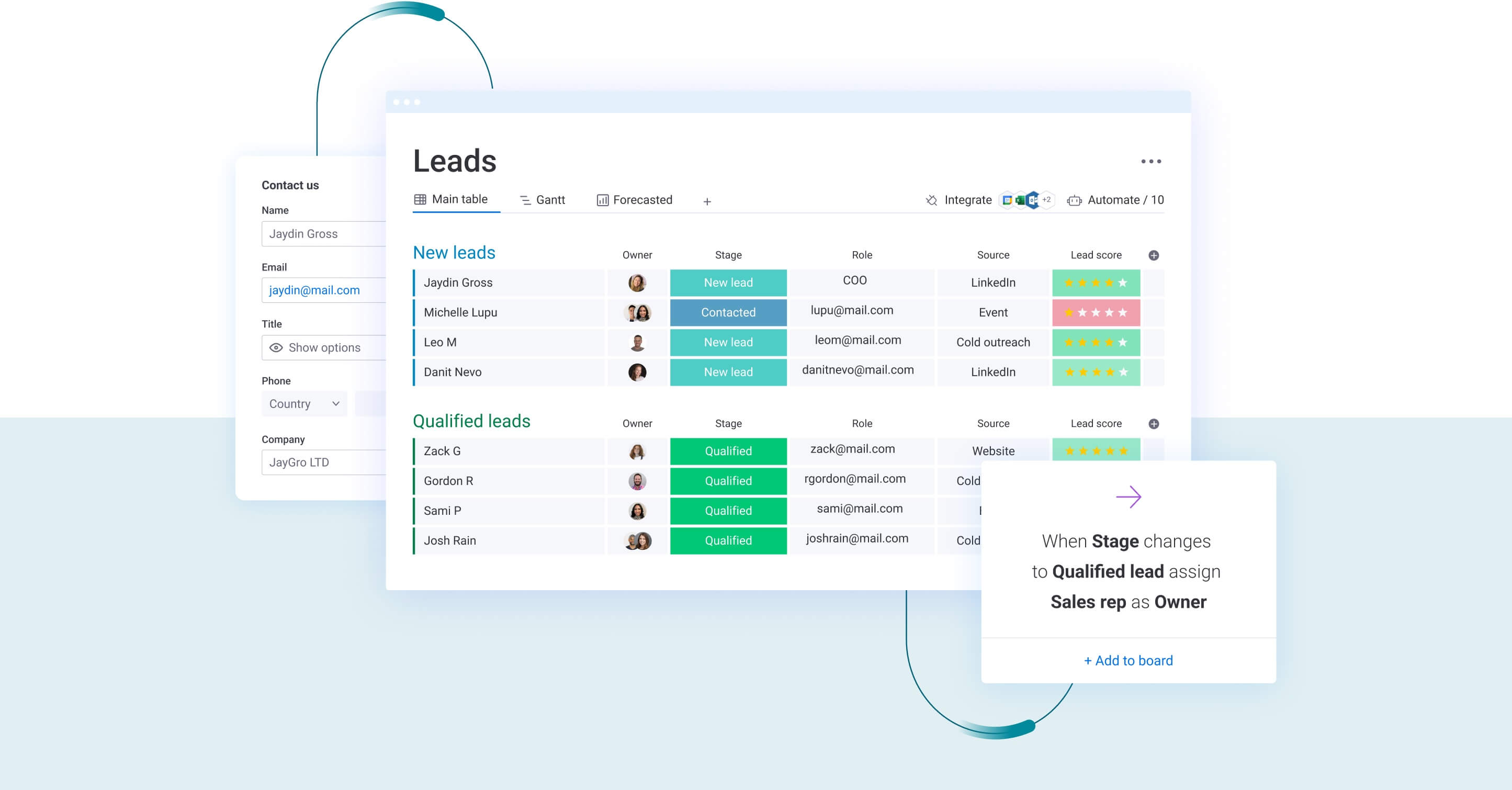
AI lead scoring uses machine learning to automatically rank potential customers by their likelihood of purchasing, effectively providing real-time data analysis 24/7 without manual input.
Unlike traditional scoring that relies on manual scoring rules (e.g., assigning points for a job title), AI lead scoring analyzes hundreds of data points simultaneously, including engagement and past behavior, and continuously learns which combinations predict conversion.
This offers a crucial speed advantage: AI scores thousands of leads in seconds, spotting patterns humans miss (such as the correlation between specific mobile page visits and conversion rates). Research shows companies that use AI in sales can increase leads and appointments by more than 50%, according to McKinsey research. It spots patterns humans miss, like the fact that prospects who visit your pricing page on mobile devices between 7-9 PM are twice as likely to convert. This means your sales team always knows exactly who to call first.
How AI lead scoring works
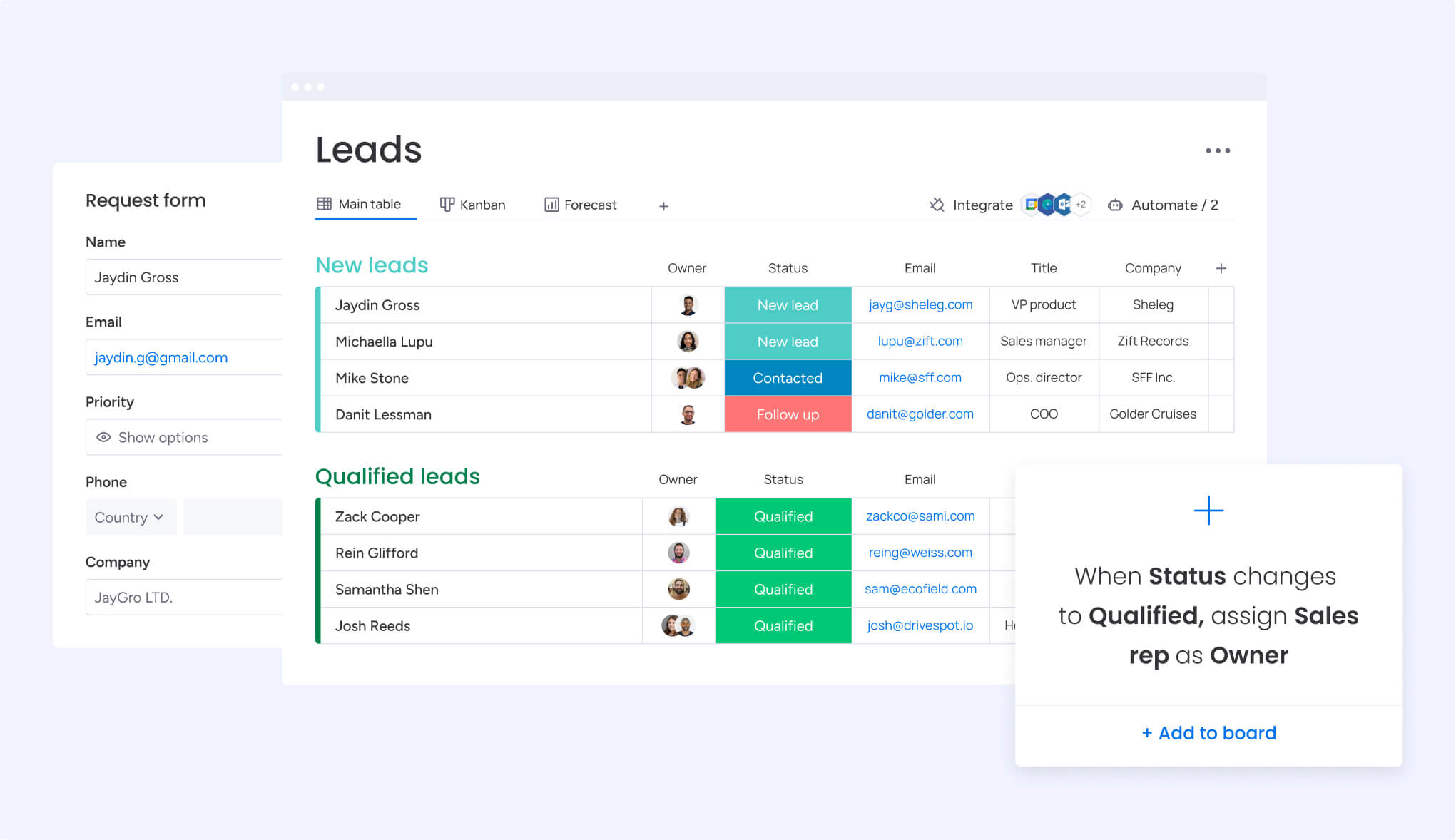
AI lead scoring is not an arbitrary process; it is a systematic approach that translates complex, unstructured data into clear, actionable priorities. The system utilizes continuous learning, ensuring its performance and accuracy improve with every iteration and outcome processed.
Data collection and intelligence gathering
The foundation of AI lead scoring is comprehensive data collection from multiple touchpoints. Your CRM becomes the central hub where all this information converges. The system automatically pulls data from various sources to build complete lead profiles:
- Website analytics: every page view, download, and form submission gets tracked and analyzed. The AI notes which content leads consume, how long they spend on specific pages, and what actions they take.
- CRM records: all your existing contact history, deal stages, and communication logs feed into the scoring model. Past interactions help predict future behavior.
- Email engagement: open rates, click-throughs, and response patterns reveal genuine interest levels. The AI distinguishes between leads who actively engage and those who just browse.
- Social signals: LinkedIn interactions, company mentions, and social media engagement provide context about brand awareness and buying intent.
- Third-party enrichment: external data about company revenue, growth trends, and technology stack fills gaps in your internal records.
Machine learning algorithms in action
The role of machine learning algorithms is that of a data detective. They thoroughly analyze your historical deals to spot the patterns that precede customer purchases. By examining both wins and losses, the system determines the factors that separate qualified leads from low-potential prospects.
These algorithms continuously refine their predictions. When a lead you thought would convert doesn’t, the system learns from that outcome. When an unexpected lead becomes your biggest deal of the quarter, the AI adjusts its model accordingly. This creates a scoring system that adapts to your unique business and evolves with market changes.
Real-time scoring updates
Scores change the moment new information arrives. A lead visits your pricing page? Their score jumps immediately. Someone from their team attends your webinar? The score adjusts within seconds. This instant responsiveness means you can catch leads at their moment of highest interest.
The speed advantage is dramatic. Traditional scoring might update weekly or monthly. AI scoring happens continuously, ensuring your sales team always works from current information. When a lead’s behavior signals buying intent, your team knows instantly.
Continuous learning and improvement
Your system gets smarter with every deal: wins show what works, losses reveal red flags, and even those stalled opportunities teach you about timing and engagement.
This feedback loop requires no manual intervention. The AI automatically incorporates new outcomes into its model, making future predictions more accurate. After six months, your scoring system understands your specific market with more precision than any generic model ever could.
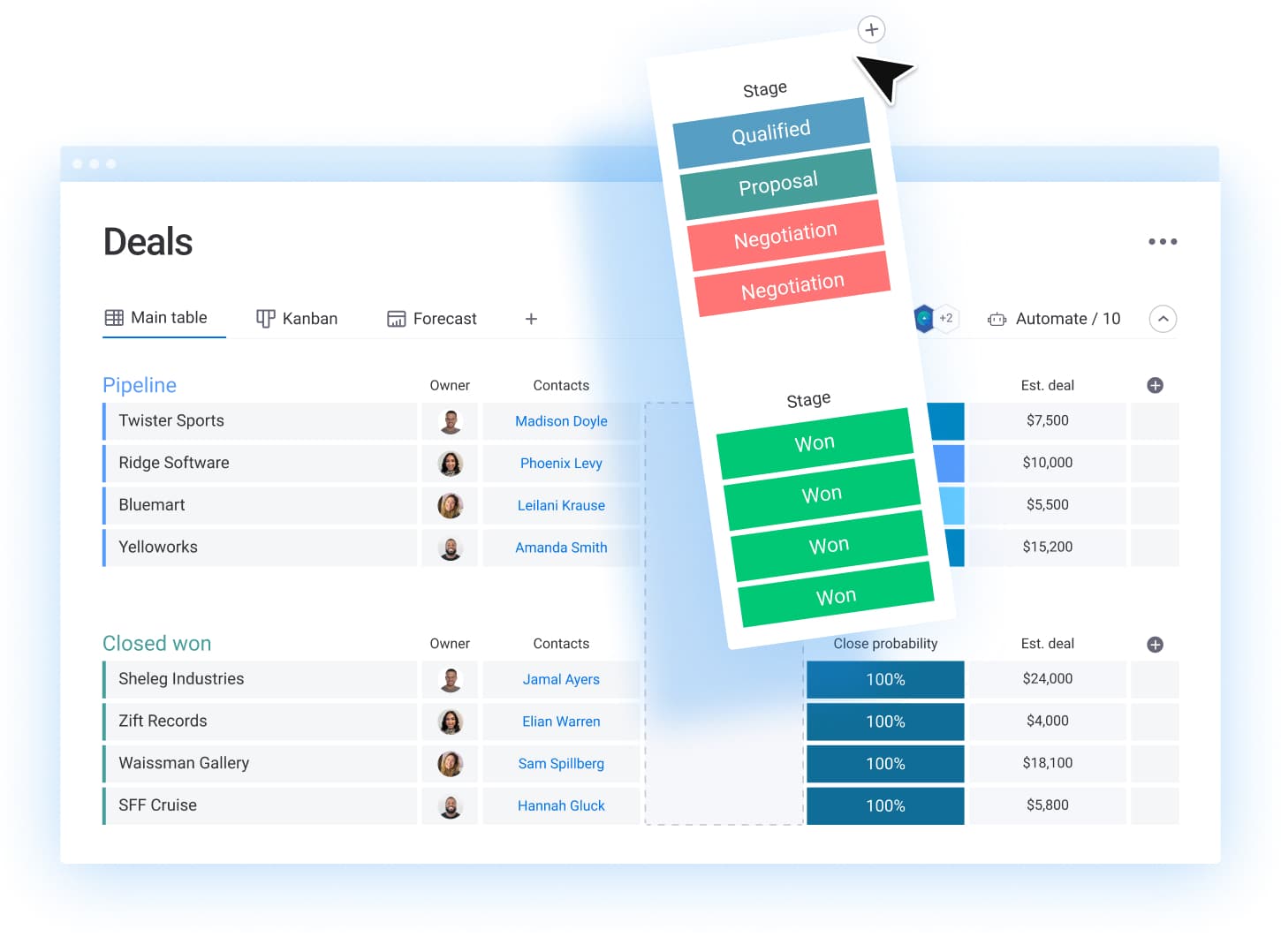
AI lead scoring vs traditional lead scoring
As your lead volume explodes and buyers take increasingly complicated journeys, traditional scoring simply can’t keep up with AI. Understanding these differences helps you see why AI has become essential for competitive sales teams.
Where traditional scoring falls short
Manual scoring creates friction that slows your sales team’s momentum, a challenge that intensifies as you grow:
- Human error creeps in everywhere: sales reps manually entering scores make mistakes. They forget to update records. They apply criteria inconsistently. One rep’s “hot lead” is another’s “maybe later.”
- Volume overwhelms the system: when you’re dealing with hundreds of leads weekly, manual scoring becomes impossible. High-value prospects slip through cracks while reps waste time on poor fits.
- Static rules miss nuance: your scoring criteria from last year might be completely wrong today. Market conditions change. Buyer behaviors shift. But updating manual rules takes massive effort.
- Updates lag behind reality: by the time monthly scoring reviews happen, hot leads have gone cold. Opportunities disappear while waiting for human evaluation.
- Bias affects decisions: reps unconsciously favor certain industries or company sizes. They might overlook great leads that don’t fit their mental model of an ideal customer.
AI lead scoring advantages
AI fixes these problems head-on, completely changing how you handle leads:
| Aspect | Traditional scoring | AI scoring |
|---|---|---|
| Speed | Manual updates take hours or days | Instant scoring within seconds |
| Accuracy | Prone to human error and inconsistency | Data-driven predictions improve continuously |
| Scale | Breaks down with high volumes | Handles unlimited leads effortlessly |
| Adaptability | Requires manual rule updates | Automatically adjusts to new patterns |
| Objectivity | Subject to individual bias | Applies consistent logic across all leads |
Making the transition
Switching to AI scoring isn’t the headache you might expect. Advanced solutions like monday CRM handle the heavy lifting, making the transition surprisingly simple. You connect your existing data sources, map your current lead fields, and let the AI analyze your historical patterns.
The system starts learning immediately from your past wins and losses. Within days, it generates initial scores. Within weeks, those scores become more accurate than manual assessments. Your team experiences immediate benefits without disrupting their workflow.
7 game-changing benefits of AI lead scoring
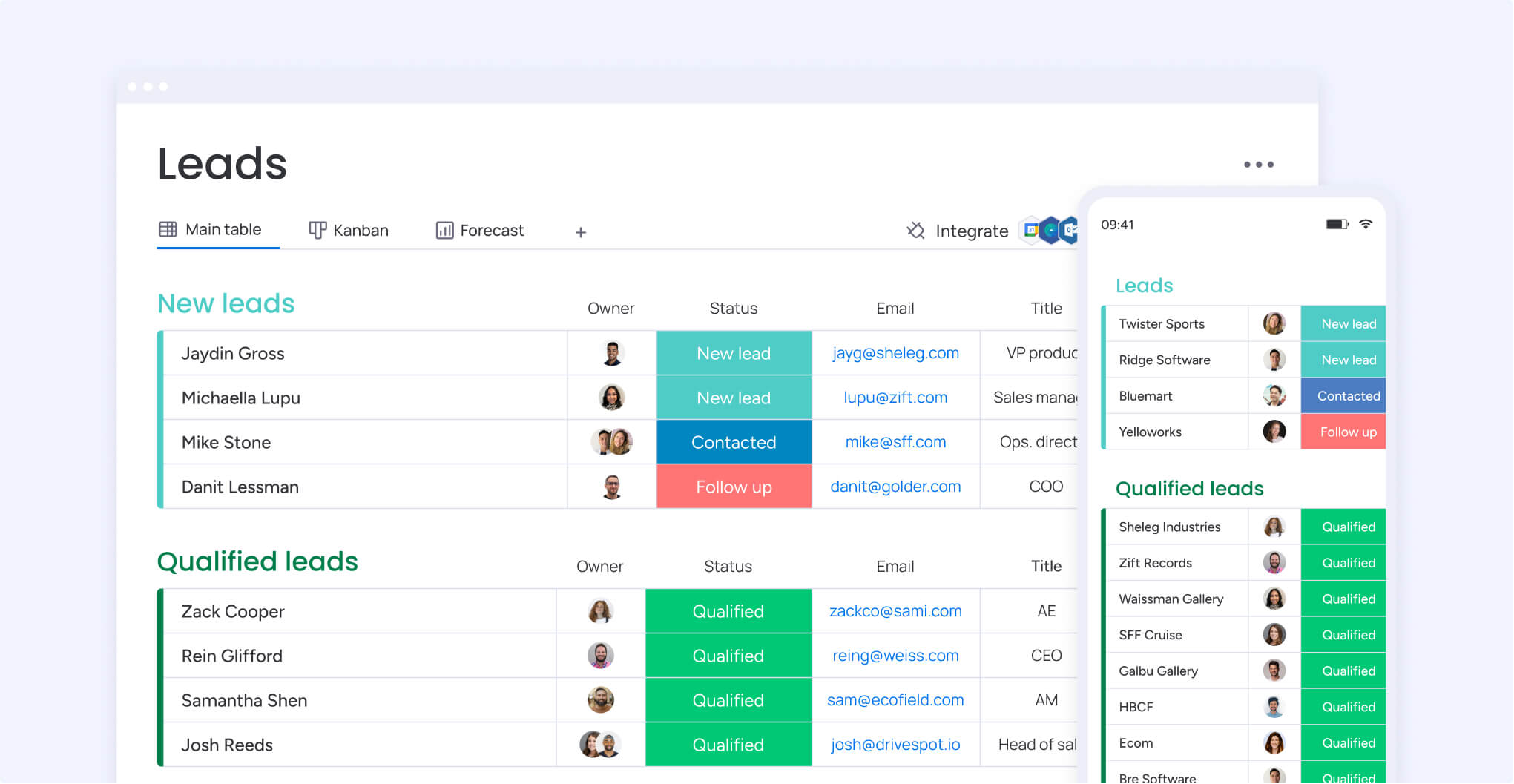
The following section outlines the measurable benefits of AI scoring, demonstrating how it addresses the core operational challenges faced by sales teams.
1. Lightning-fast lead response times
Speed-to-lead determines conversion success. Research consistently shows that responding within five minutes dramatically increases your chances of qualifying a lead. In fact, companies responding to leads within one hour are seven times more likely to have meaningful conversations with decision-makers than those who respond even an hour later, according to Harvard Business Review.
When a lead submits a form, AI instantly evaluates their profile and behavior. High-score leads get routed to available reps immediately. Your team reaches prospects while their interest peaks, not days later when they’ve moved on to competitors.
2. Maximized sales team productivity
Your reps stop wasting time on dead-end prospects. AI scoring filters out low-quality leads before they consume valuable selling time. This addresses a critical business need, as 65% of businesses cite lead generation and qualification as their top sales challenge, according to the U.S. Small Business Administration’s 2024 Small Business Trends Report.
This means reps spend their days having meaningful conversations with qualified buyers instead of chasing ghosts.
The productivity gains are measurable. Teams report spending up to 80% of their time with qualified leads, compared to just 30% with manual scoring. More quality conversations mean more closed deals.
3. Predictable pipeline performance
AI scoring brings clarity to pipeline forecasting. You know exactly which deals are likely to close because the AI has analyzed thousands of similar scenarios. This predictability helps you allocate resources effectively and set realistic targets.
Sales leaders can finally report upward with confidence. The pipeline isn’t built on hunches anymore — it’s backed by data-driven predictions that prove increasingly accurate over time.
4. Infinite scalability
Your lead volume can double, triple, or grow tenfold without breaking the system. AI handles increased volume effortlessly. You don’t need to hire additional staff just to qualify and score incoming leads.
This scalability enables aggressive growth strategies. You can launch new campaigns, enter new markets, and generate more leads without worrying about overwhelming your team.
5. Unified scoring standards
Every lead gets evaluated by the same criteria. No more inconsistencies between team members or departments. Marketing and sales finally align around shared definitions of lead quality.
This standardization improves handoffs between teams. Marketing knows exactly what constitutes a sales-ready lead. Sales trusts the leads they receive. Everyone works from the same playbook, reflecting essential CRM best practices.
6. Revenue acceleration
Faster response times plus better lead quality equals accelerated revenue. Deals close faster because reps focus on ready buyers. Conversion rates improve because the AI identifies genuine interest signals humans miss.
The compound effect is powerful. Small improvements in response time and lead quality create significant revenue gains over time.
7. Self-improving accuracy
The system gets smarter every day. Each interaction teaches the AI something new about your market and customers. Patterns that predict success become clearer. Warning signs of poor fits become obvious.
This continuous improvement happens automatically. You don’t need to manually update rules or retrain models. The AI evolves with your business, ensuring scoring remains relevant as conditions change.
6 steps to implement AI lead scoring
Implementing AI lead scoring follows a logical sequence that minimizes disruption while maximizing value. Keep in mind that each step below builds the foundation for a robust lead management process.
Step 1: assess your current lead process
Start by documenting how leads currently flow through your organization. Understanding your existing process reveals opportunities for AI to add value:
- Lead volume analysis: count how many leads you generate weekly and monthly. This determines the scale of solution you need.
- Conversion rate review: calculate current conversion rates at each funnel stage. These become your baseline metrics for measuring AI impact.
- Response time audit: measure how quickly your team currently responds to new leads. This highlights the urgency of implementing AI scoring.
- Data quality check: review your CRM data completeness and accuracy. Clean data produces better AI predictions.
Step 2: define your ideal customer profile
Your ideal customer profile (ICP) guides the AI toward recognizing high-value leads. Build this profile from your best existing customers:
- Demographic patterns: identify common characteristics like company size, industry, and location among your most successful customers.
- Behavioral indicators: note which actions your best customers took before buying. Did they attend webinars? Download specific content? Visit certain pages?
- Conversion signals: document the behaviors that consistently predict closed deals in your sales process.
Step 3: select your AI scoring platform
Choose a platform that fits your team’s technical capabilities and business needs. Key selection criteria include:
- Ease of use: look for intuitive interfaces that don’t require data science expertise. Platforms like monday CRM offer no-code setup that gets you running quickly.
- Integration depth: ensure the platform connects seamlessly with your existing CRM and marketing tools.
- Transparency: select systems that explain their scoring logic. You need to understand and trust the AI’s decisions.
- Scalability: choose a solution that grows with your business without requiring platform changes.
Step 4: connect your data sources
Data connectivity determines AI effectiveness. Connect all relevant data sources to give the AI complete visibility:
Your CRM provides the foundation with contact records and interaction history. Marketing automation platforms add engagement data. Website analytics reveal browsing behavior. Email systems track communication patterns.
Modern lead management software handles these connections through pre-built integrations. Platforms like monday CRM automatically sync with your existing tools, eliminating manual data transfers.
Step 5: train your sales team
Successful adoption depends on team buy-in. Help your reps understand how AI scoring makes their jobs easier:
- Demonstrate value: show how AI scoring helps them focus on winnable deals. Use real examples from your pipeline.
- Address concerns: some reps worry AI will replace them. Emphasize that AI handles repetitive tasks so they can focus on relationship building.
- Provide training: ensure everyone understands how to interpret scores and when to override AI recommendations.
Step 6: monitor and optimize
Launch doesn’t mean you’re done. Continuous monitoring ensures the system delivers expected value:
Track key metrics like response times, conversion rates, and deal velocity. Compare results to your baseline measurements. Gather feedback from sales reps about score accuracy.
Adjust scoring thresholds based on results. If too many low-quality leads get high scores, raise the threshold. If good leads get filtered out, lower it. The AI learns from these adjustments, improving future predictions.
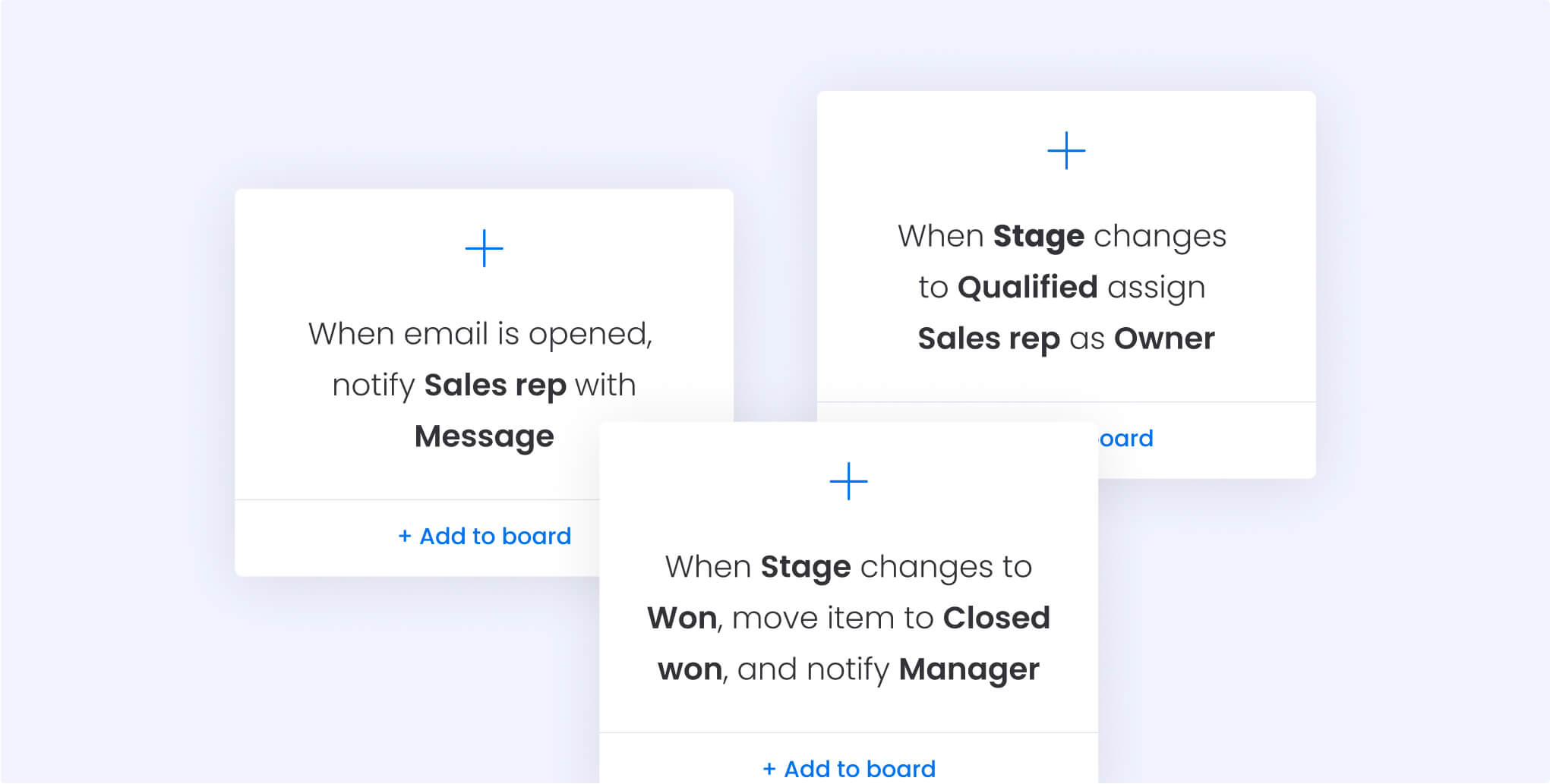
AI lead scoring best practices for success
Want to squeeze every drop of value from your AI scoring? Focus on clean data, get your team on board, and keep fine-tuning your approach.
Foundation of quality data
Clean, complete data powers accurate predictions. Poor data quality undermines even the most sophisticated AI. Regular data maintenance prevents scoring errors:
- Remove duplicates: duplicate records confuse the AI and inflate lead counts. Regular deduplication keeps your database clean.
- Fill information gaps: incomplete profiles limit scoring accuracy. Use enrichment tools to add missing company and contact details.
- Standardize formats: consistent data formatting helps AI recognize patterns. Standardize company names, job titles, and industry classifications.
Strategic scoring thresholds
Setting appropriate thresholds determines which leads receive immediate attention. These thresholds need regular adjustment based on team capacity and market conditions.
Start with conservative thresholds that only surface your highest-scoring leads. This builds team confidence in the system. Gradually lower thresholds as your team becomes comfortable with AI recommendations. Monitor conversion rates at each threshold level to find your optimal settings.
Sales and marketing alignment
AI scoring bridges the gap between marketing and sales. Both teams must understand and trust the scoring system. Regular alignment meetings ensure everyone interprets scores consistently.
Marketing learns which campaigns generate high-scoring leads. Sales provides feedback on score accuracy. This collaboration improves lead quality over time. Platforms like monday CRM facilitate this alignment by giving both teams visibility into the same scoring data.
Performance metrics that matter
Use a lead analytics dashboard to track metrics that directly connect to business outcomes. Focus on measurements that demonstrate AI scoring impact:
- Lead response time: measure how quickly reps contact high-scoring leads. Faster response should correlate with higher conversion.
- Conversion rate by score: track how often leads at different score levels convert. This validates scoring accuracy.
- Sales velocity: monitor how quickly deals move through your pipeline. AI scoring should accelerate deal progression.
- Revenue per lead: calculate average revenue from leads at different score tiers. Higher scores should generate larger deals.
Continuous model refinement
Your AI model isn’t set-it-and-forget-it. Markets shift, competitors launch new products, and your ideal buyer evolves: your scoring system needs to keep pace with these changes.
Review scoring accuracy monthly. Identify patterns where scores don’t match outcomes. Feed this information back to the system. Modern platforms like monday CRM handle this refinement automatically, learning from every closed deal.
How to choose your AI lead scoring solution
Choosing the wrong platform can sink your AI scoring project before it starts. Look for platforms that fit how your team actually works, not ones that require a data science degree.
No-code platform requirements
The beauty of today’s no-code platforms? You can build powerful AI scoring without hiring a single data scientist or bothering your IT team. Look for these no-code capabilities:
Visual workflow builders let you design scoring logic through drag-and-drop interfaces. Pre-built templates accelerate setup with industry-specific scoring models. Intuitive dashboards make score interpretation straightforward for non-technical users.
Solutions like monday CRM exemplify this approach with AI features that activate in minutes. You configure scoring rules through simple forms, not complex code.
Essential integration features
Seamless integration determines how effectively AI scoring fits your workflow. Critical integration points include:
- CRM synchronization: real-time syncing ensures scores reflect current data. Look for bi-directional sync that updates both systems automatically.
- Marketing automation connection: email engagement and campaign responses should influence scores immediately.
- Communication platform linking: phone calls, meetings, and chat interactions provide valuable scoring signals.
- Analytics tool compatibility: connect your BI tools to analyze scoring performance and ROI.
Modern pricing models
Transparent pricing helps you budget effectively. Avoid platforms with hidden fees or complex licensing structures. Modern solutions offer scalable pricing that grows with your business.
Look for platforms that charge based on actual usage, not potential capacity. This ensures you only pay for value received. Some platforms include AI scoring in their standard CRM offering, eliminating additional costs.
Implementation support
Quality support accelerates time-to-value. Evaluate support offerings before committing to a platform:
- Onboarding assistance: guided setup ensures proper configuration from day one.
- Training resources: video tutorials and documentation help your team maximize platform value.
- Ongoing optimization help: regular check-ins ensure your scoring model continues performing well.
The future of lead scoring with digital workers
AI lead scoring evolves beyond passive ranking into active AI lead management. Digital workers represent this next evolution, combining scoring intelligence with autonomous action.
Proactive lead engagement
Digital workers don’t just score leads — they engage them. When a lead reaches a qualifying score, the digital worker initiates contact automatically. This might mean sending a personalized email, scheduling a call, or sharing relevant content.
The AI SDR Agent in monday CRM exemplifies this evolution. It calls new leads within seconds, qualifies them through intelligent conversation, and books meetings with your sales team. Your reps only speak with pre-qualified buyers who are ready for serious discussions.
Autonomous lead qualification
Digital workers conduct initial qualification conversations that previously required human SDRs. They ask discovery questions, assess fit, and gather essential information before involving human reps.
This 24/7 availability means no lead waits for qualification. Whether a lead arrives at midnight or during a holiday weekend, the digital worker responds immediately. The system logs every interaction in your CRM, maintaining complete visibility.
AI-powered deal facilitation
Beyond initial scoring and qualification, digital workers actively facilitate deal progression. They send follow-up emails at optimal times, remind reps about important next steps, and coordinate stakeholder involvement.
When deals stall, digital workers identify the bottleneck and suggest solutions. They might recognize that legal review is taking too long or that a key decision-maker hasn’t been engaged. This proactive support keeps deals moving forward.
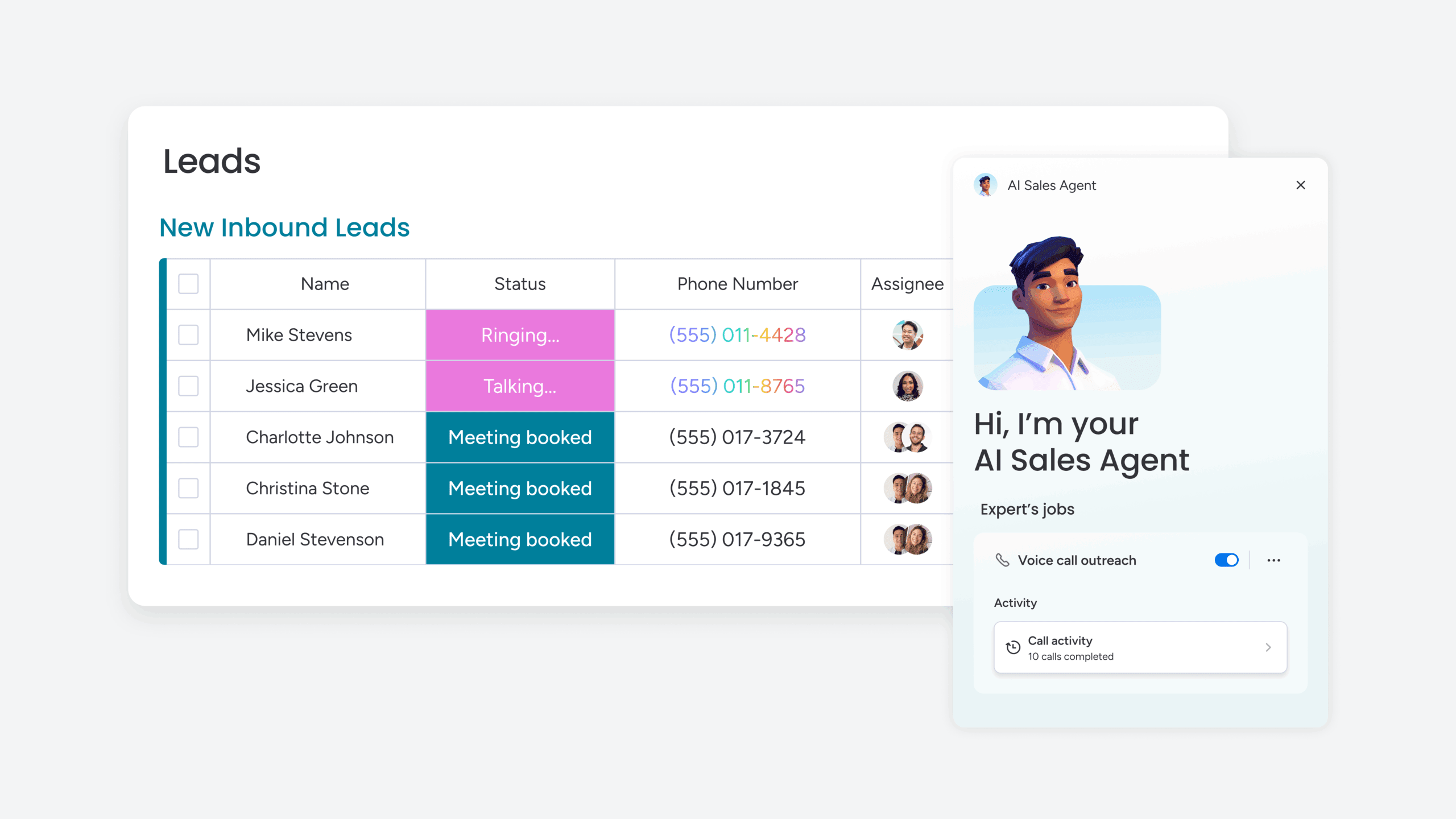
Accelerate your sales success with monday CRM
monday CRM transforms AI lead scoring from a concept into practical reality. The platform combines sophisticated AI capabilities with intuitive design that any team can master.
AI Blocks for instant lead intelligence
AI Blocks in monday CRM add intelligence to your existing workflows without complex setup. These modular AI components analyze lead data, detect buying signals, and surface insights automatically.
You can configure AI Blocks to categorize leads by industry, extract key information from communications, or identify sentiment in customer interactions. Each block operates within your familiar CRM interface, making advanced AI accessible to every team member.
Deal Facilitator digital worker
The Deal Facilitator acts as your virtual sales assistant, monitoring deal progress and identifying opportunities for acceleration. It tracks deal momentum, flags at-risk opportunities, and suggests optimal next actions.
This digital worker learns from your successful deals to guide current opportunities. It might notice that deals with multiple stakeholders involved early close faster, then prompt reps to expand their engagement accordingly.
Complete sales visibility
monday CRM provides comprehensive visibility into your entire lead scoring and sales process. Custom dashboards show score distributions, conversion rates by score tier, and team performance metrics.
Real-time updates mean everyone works from current information. Marketing sees which campaigns generate high-scoring leads. Sales tracks their pipeline of qualified opportunities. Leadership monitors overall scoring effectiveness and ROI.
Frequently asked questions
What's the difference between AI lead scoring and predictive lead scoring?
The primary difference between AI lead scoring and predictive lead scoring is that predictive scoring is a subset of AI lead scoring that specifically focuses on forecasting conversion probability. AI lead scoring encompasses broader capabilities including real-time adaptation, pattern recognition, and continuous learning from new data.
How much data do I need to start AI lead scoring?
Most AI scoring systems need at least 100-200 historical leads with known outcomes to identify initial patterns. More data improves accuracy, but modern platforms can start generating useful insights with relatively small datasets.
Can small sales teams benefit from AI lead scoring?
Small teams often benefit most from AI scoring because it multiplies their capacity without adding headcount. AI handles lead qualification and prioritization, letting small teams punch above their weight class.
How does AI lead scoring handle data privacy?
Modern AI platforms implement encryption, access controls, and audit trails to protect sensitive data. They comply with regulations like GDPR and maintain strict data governance standards.
What's the typical ROI timeline for AI lead scoring?
Teams typically see initial improvements in lead response time within days. Conversion rate improvements become measurable within four to six weeks as the AI learns your specific patterns.
How do digital workers differ from traditional lead scoring?
Digital workers actively engage and qualify leads through calls and emails, while traditional scoring only ranks leads passively. Digital workers take autonomous action based on scores rather than waiting for human intervention.
 Get started
Get started 

